Western Union (alliance)
| Western Union | |||||||||
|---|---|---|---|---|---|---|---|---|---|
| 1948–1954 | |||||||||
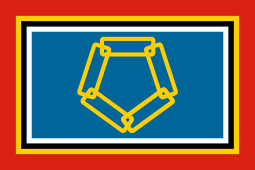 Flag
 Badge
| |||||||||
 | |||||||||
| Status | Alliance | ||||||||
| Capital |
Fontainebleau, France London, United Kingdom | ||||||||
| Historical era | Cold War | ||||||||
| 21–25 February 1948 | |||||||||
| 17 March 1948 | |||||||||
• WUDO established | 28 September 1948 | ||||||||
• Korean War breaks out | 25 June 1950 | ||||||||
• NATO absorbs WUDO | 1951 | ||||||||
| 23 October 1954 | |||||||||
| |||||||||
| Today part of |
| ||||||||
Part of a series on the |
||||||||||||||||||||||||
|---|---|---|---|---|---|---|---|---|---|---|---|---|---|---|---|---|---|---|---|---|---|---|---|---|
| History of the European Union |
||||||||||||||||||||||||
 | ||||||||||||||||||||||||
|
Organisation
|
||||||||||||||||||||||||
|
||||||||||||||||||||||||
|
||||||||||||||||||||||||
|
| ||||||||||||||||||||||||
The Western Union (WU), also referred to as the Brussels Treaty Organisation (BTO),[1] was the European military alliance established between France, the United Kingdom (UK) and the three Benelux countries in September 1948 in order to implement the Treaty of Brussels signed in March the same year.[Note 1] Under this treaty the signatories, referred to as the five powers, agreed to collaborate in the defence field as well as in the political, economic and cultural fields.
During the Korean War (1950–1953), the headquarters, personnel and plans of the WU's defence arm, the Western Union Defence Organisation (WUDO), were transferred to the newly established North Atlantic Treaty Organisation (NATO), providing the nucleus of NATO's command structure at the Supreme Headquarters Allied Powers Europe (SHAPE). As a consequence of the failure of the European Defence Community in 1954, the London and Paris Conferences led to the Modified Treaty of Brussels (MTB) through which the Western Union was transformed into the Western European Union (WEU) and was joined by Italy and West Germany. As the WEU's functions were transferred to the European Union's (EU) European Security and Defence Policy (ESDP) at the turn of the 21st century, the Western Union is a precursor of both NATO and the military arm of the EU.
History
Background
In the aftermath of World War II there were fears of a renewal of German aggression, and on 4 March 1947 the Treaty of Dunkirk was signed by France and the United Kingdom as a Treaty of Alliance and Mutual Assistance in the event of a possible attack.
In his speech to the House of Commons on 22 January 1948, British Foreign Secretary Ernest Bevin called for the extension of the Treaty of Dunkirk to also conclude the Benelux countries, creating a Western Union.[2] The object was to consolidate Western Europe to satisfy the United States and to give advance notice of the eventual incorporation of Italy, and then Germany, into the Treaty.
The negotiating conference was held on 4 March 1948, a few days after the coup in Prague; thanks to this, the three smaller countries were able to persuade the others to agree to the concept of automatic and immediate mutual assistance in the event of aggression, and to the idea of setting up a regional organisation (a multilateral alliance in accordance with Article 51 of the Charter of the United Nations).
The Western Union was intended to provide Western Europe with a bulwark against the communist threat and to bring greater collective security.[3]
Formation
The Treaty of Brussels was signed on 17 March 1948 between Belgium, France, Luxembourg, the Netherlands and the United Kingdom, and was an expansion to the preceding year's defence pledge, the Dunkirk Treaty signed between Britain and France.

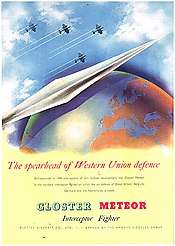
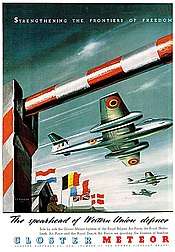
Although the Treaty goes no further than providing for 'cooperation' between the contracting parties, 'which will be effected through the Consultative Council referred to in Article VII as well as through other bodies', in practice the arrangement was referred to as Western Union or the Brussels Treaty Organisation.
Cannibalisation and marginalisation
When the division of Europe into two opposing camps became considered unavoidable, the threat of the USSR became much more important than the threat of German rearmament. Western Europe, therefore, sought a new mutual defence pact involving the United States, a powerful military force for such an alliance. The United States, concerned with containing the influence of the USSR, was responsive. Secret meetings began by the end of March 1949 between American, Canadian and British officials to initiate the negotiations that led to the signing of the North Atlantic Treaty on 4 April 1949 in Washington, DC.
The need to back up the commitments of the North Atlantic Treaty with appropriate political and military structures led to the creation of the North Atlantic Treaty Organisation (NATO). In December 1950, with the appointment of General Eisenhower as the first Supreme Allied Commander Europe (SACEUR), the members of the Treaty of Brussels decided to transfer the headquarters, personnel, and plans of the Western Union Military Organisation (WUDO) to NATO.[4] NATO's Supreme Headquarters Allied Powers Europe (SHAPE) took over responsibility for the defence of Western Europe, while the physical headquarters in Fontainebleau were transformed into NATO's Headquarters, Allied Forces Central Europe (AFCENT).[5][6][7][8]
As WUDO's capacities were transferred to NATO's SHAPE, Field Marshal Bernard Montgomery resigned as Commanders-in-Chief Committee Chairman on 31 March 1951 and took the position of deputy SACEUR Supreme Allied Commander Europe on 1 April 1951.
The establishment of NATO, along with the signing of a succession of treaties establishing the Organisation for European Economic Cooperation (April 1948), the North Atlantic Treaty Organisation (April 1949), the Council of Europe (May 1949) and the European Coal and Steel Community (April 1951), left the Western Union and its founding Treaty of Brussels was left devoid of much of its authority.
Transformation into the Western European Union
The Western Union's founding Treaty of Brussels was amended at the 1954 Paris Conference as a result of the failure of the Treaty establishing the European Defence Community to gain French ratification: The General Treaty (German: Deutschlandvertrag) of 1952 formally named the EDC as a prerequisite of the end of Allied occupation of Germany, and there was a desire to include Germany in the Western defence architecture. The Modified Brussels Treaty (MBT) transformed the Western Union into the Western European Union (WEU), at which point Italy and Germany were admitted. Although the WEU established by the Modified Brussels Treaty was significantly less powerful and ambitious than the original Western Union, German membership of the WEU was considered sufficient for the occupation of the country to end in accordance with the General Treaty.[9]
Social and cultural aspects were handed to the Council of Europe to avoid duplication of responsibilities within Europe.[10]
| Signed: In force: Document: |
1947 1947 Dunkirk Treaty |
1948 1948 Brussels Treaty |
1951 1952 Paris Treaty |
1954 1955 Modified Brussels Treaty |
1957 1958 Rome Treaty & EURATOM |
1965 1967 Merger Treaty |
1975 1976 Council Agreement on TREVI |
1986 1987 Single European Act |
1985+90 1995 Schengen Treaty & Convention |
1992 1993 Maastricht Treaty (TEU) |
1997 1999 Amsterdam Treaty |
2001 2003 Nice Treaty |
2007 2009 Lisbon Treaty |
|||
| Content: | (est. alliance) | (founded WU) | (founded ECSC) | (protocol amending WU to become WEU) | (founded EEC and EURATOM) | (merging the legislative & administrative bodies of the 3 European communities) | (founded TREVI) | (amended: EURATOM, ECSC, EEC)+ (founded EPC) |
(founded Schengen) (implemented Schengen) |
(amended: EURATOM, ECSC, and EEC to transform it into EC)+ (founded: JHA+CFSP) |
(amended: EURATOM, ECSC, EC to also contain Schengen, and TEU where PJCC replaced JHA) | (amended with focus on institutional changes: EURATOM, ECSC, EC and TEU) | (abolished the 3 pillars and WEU by amending: EURATOM, EC=>TFEU, and TEU) (founded EU as an overall legal unit with Charter of Fundamental Rights, and reformed governance structures & decision procedures) |
|||
| Three pillars of the European Union: | ||||||||||||||||
| European Communities (with a single Commission & Council) |
||||||||||||||||
| European Atomic Energy Community (EURATOM) | ||||||||||||||||
| European Coal and Steel Community (ECSC) | Treaty expired in 2002 | European Union (EU) | ||||||||||||||
| European Economic Community (EEC) | European Community (EC) | |||||||||||||||
| Schengen Rules | ||||||||||||||||
| Terrorism, Radicalism, Extremism and Violence Internationally (TREVI) | Justice and Home Affairs (JHA) |
Police and Judicial Co-operation in Criminal Matters (PJCC) | ||||||||||||||
| European Political Cooperation (EPC) | Common Foreign and Security Policy (CFSP) | |||||||||||||||
| Franco-British alliance | Western Union (WU) | Western European Union (WEU) | ||||||||||||||
| Treaty terminated in 2011 | ||||||||||||||||
Social, cultural initiative
The Treaty of Brussels had cultural and social clauses, concepts for the setting up of a 'Consultative Council'. The basis for this was that a cooperation between Western nations would help stop the spread of Communism.
Defence Organisation
| Western Union Defence Organisation | |
|---|---|
 | |
| Active | 28 September 1948[11] |
| Disbanded | 20 December 1951 |
| Countries |
Belgium France Luxembourg Netherlands United Kingdom |
| Branch |
Navy (UNIMER) Army (UNIAIR) Air force (UNITER) |
| Type | Multinational military organisation |
| Size | c. 100 officers and 300 other personnel[12] |
| Part of | Western Union |
| Garrison/HQ | Fontainebleau, France |
| Engagements | Cold War |
| Commanders | |
| CinC Comm. Chairman | FM Montgomery |
| CinCLand | Gen. Lattre |
| CinCAir | ACM Robb |
| FOWE | Vice-Adm. Jaujard |
From April 1948, the member states of the Western Union decided to create a military agency under the name of the Western Union Defence Organisation (WUDO). WUDO was formally established on September 27–28, 1948.[13][5][14]
Objective
The objective of WUDO was to provide for the coordination of defence between the five powers in the military and supply fields and for the study of the tactical problems of the defence of Western Europe; in addition, to provide a framework on which, in the event of any emergency, a command organization could be built up.
The Treaty of Brussels contained a mutual defence clause as set forth in Article IV:
- If any of the High Contracting Parties should be the object of an armed attack in Europe, the other High Contracting Parties will, in accordance with the provisions of Article 51 of the Charter of the United Nations, afford the Party so attacked all the military and other aid and assistance in their power.[15]
Article V set forth the obligations of Brussels Pact members to cooperate with the United Nations Security Council to maintain international peace and security, and Article VI set forth the obligations of Brussels Pact members to not enter any third-party treaties that conflicted with the Treaty of Brussels.[15]
Structure
The overall command structure was patterned after the wartime Supreme Headquarters Allied Expeditionary Force (SHAEF), which included a joint planning staff.[13] WUDO could also be compared with the defence organisation in the United Kingdom.

:

London: Defence Committee, Military Supply Board, Chiefs-of-Staff Committee
Fontainebleau: Commanders-in-Chief Committee
Defence Committee
Government direction and control is provided by the Western Union Defence Committee which, in peacetime, was composed of the national defence ministers. The Defence Committee was served by the Chiefs-of-Staff Committee and the Military Supply Board, meeting regularly in London. These bodies were analogous to [the UK's] Chiefs of Staff Committee and Joint War Production Staff, respectively.
Secretariat
The secretariat worked for the other bodies, and had a British Secretary General.
Military Supply Board
In parallel with this Chiefs-of—Staff organisation, the Western Union Military Supply Board advised the Defence Committee on all questions affecting military supplies and made recommendations as to how the requirements of the Five Powers for Military Supplies could be met. The Supply Board was on a high level and is composed of one representative from each country. The British representative, who is to be chairman for the first year, is also Chairman of the British Joint War Production Staff. The infrequent meetings of the Board were served by a permanent Executive Committee working in London, composed of representatives from each country.
Chiefs-of-Staff Committee
The Western Union Chiefs of Staff Committee (WUCOS), based in London, United Kingdom,[16] consisted of the five national chiefs of staff.[17]
WUCOS directed the operative organisation and advised the Defence Committee on all matters affecting the defence of Western Europe, taking account of commitments in other parts of the world. Within this broad direction its special tasks were to ensure that within Western Europe questions such as:
- The military resources of the five countries are organized to meet the strategic requirements of the Allies.
- The forces of the various nations are welded into an effective fighting machine.
- The combined resources of the five nations are allotted in the best way.
- A proper balance is maintained between the conflicting requirements of internal security and home defence on the one hand, and the European battle on the other.
- The evaluation, preparation and distribution of the necessary resources, in particular to the Commander of the European battle, whose special task will be to make the necessary operational plans and to put them into operation.
- The exact area of the responsibility of the command of the European battle in war is to be defined. It will be necessary to keep this constantly under review.
WUCOS included observers from the United States and Canada. This American liaison mission was initially led by Major General Lyman L. Lemnitzer, U.S. Army, and subsequently by Major General A. Franklin Kibler, USA.[18]
Commanders-in-Chief Committee

The Western Union Commanders-in-Chief Committee, responsible to the Western Union Chiefs-of-Staff Committee, was created on 5 October 1948.[6][20]
The committee consisted of Western Union Commanders-in-Chief for the three military branches (Land, Naval and Air), as well as the senior officer, designated Chairman. Their immediate task was to study the tactical problems of the defence of Western Europe, i.e. make plans to meet a Russian armed threat in Western Europe. They did not assume executive command of any forces in peacetime, although they were in close contact with Military Governors of the occupation zones, and it is hoped that it may be possible, to a limited extent, to adjust peacetime dispositions to meet the needs of defence.
| Portrait | Name | Title | Defence branch | Nationality |
|---|---|---|---|---|
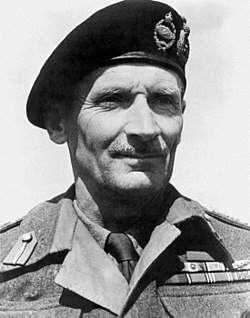 |
Field Marshal Bernard Montgomery.[18] | Chairman | British Army | United Kingdom |
.jpg) |
General Jean de Lattre de Tassigny | Commander-in-chief, Land Forces, Western Europe (CinCLand) | French Army | France |
 |
Air Chief Marshal Sir James Robb | Commander-in-chief, Air Forces, Western Europe (CinCAir) | Royal Air Force | United Kingdom |
 |
Vice-Admiral Robert Jaujard | Flag Officer, Western Europe (FOWE)[21][13][22] | French Navy | France |
The committee formed a nucleus command organisation in the French town of Fontainebleau, south of Paris, known as the Combined Allied Command of WUDO (UNILION), which, in war, would be capable of commanding all land forces and supporting air forces to meet a Russian armed threat. UNILION employed c. 100 officers and 300 other personnel.[12]
The top-level headquarters of UNILION, with the office of the C-in-C Committee Chairman, was housed in Château des Fougères in Fontainebleau's neighbouring commune of Avon.[23][19]
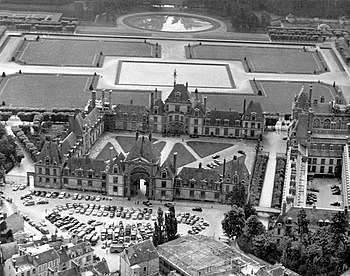
Quartier Henri IV
(48°24′10″N 2°42′8″E / 48.40278°N 2.70222°E) housed the air, sea and land commands
of the Combined Allied Command. Prior to World War II these
offices housed the Artillery School.
UNILION's three subordinate commands, for each service, were housed in the Henri IV quarter at the Palace of Fontainebleau:
- Sea Command (UNIMER)
- Air Command (UNIAIR)
- Land Command (UNITER)
Much ill-feeling was caused in the headquarters from disagreements between Chairman Montgomery and de CinCLand Lattre.[24][25]
Château de Courances served as private residence for Chairman Montgomery.[22][6][7]
Operational history
Exercises
The Western Union undertook the following training exercises (incomplete list):
- Exercise Verity (Naval; 1949) - involving 60 warships from the British, French, and Dutch navies held in the Bay of Biscay during July 1949.[26] The exercise was under the overall command of Admiral of the Fleet Sir Rhoderick McGrigor, RN, the Commander-in-Chief, Home Fleet.[26][27] The 60-ship flotilla included the British battleship Anson; the British carriers Implacable, Victorious and Theseus; and the French carrier Arromanches.[26] Admiral McGrigor summarized the accomplishments of Exercise Verity by noting: "The object of these manoeuvres is to show that we are willing and able to work together in case of aggression. I can say straight away that it's been a very great success."[26] Following Exercise Verity, WUDO announced that a major ground military exercise was scheduled for Fall 1949 under overall command of Général d'Armée Jean de Lattre de Tassigny.[26][Note 2]
- Exercise Cupola (Air; 1950)[28]
- Operation Bulldog (Air, 1949)[29]
Planned clandestine operations
- Operation Gladio, a clandestine "stay-behind" operation preparing for, and implementing, armed resistance in the event of a Warsaw Pact invasion and conquest.
See also
Notes
- Footnotes
- ↑ Although the Treaty goes no further than providing for 'cooperation' between the contracting parties, 'which will be effected through the Consultative Council referred to in Article VII as well as through other bodies', in practice the arrangement was referred to as Western Union or the Brussels Treaty Organisation.
- ↑ There is not documentary evidence that this ground military exercise ever took place.
- Citations
- ↑ https://www.bbc.co.uk/news/special/politics97/news/06/0616/jargon.shtml
- ↑ https://www.cvce.eu/content/publication/2002/9/9/7bc0ecbd-c50e-4035-8e36-ed70bfbd204c/publishable_en.pdf
- ↑ https://www.cvce.eu/en/collections/unit-content/-/unit/d5906df5-4f83-4603-85f7-0cabc24b9fe1/051bd03c-4887-4f53-82eb-0f12e59f8dbd
- ↑ Hansard extract February 18, 1957
- 1 2 Duke, Simon (2000). The elusive quest for European security: from EDC to CFSP. Basingstoke, UK: Palgrave Macmillan. pp. 13–14. ISBN 978-0-312-22402-8. Retrieved 2010-11-27.
- 1 2 3 "Did you know that Europe already had a defensive military alliance prior to NATO?". Allied Command Operations (ACO). NATO. 2010. Retrieved 2010-08-08.
- 1 2 Kaplan, Lawrence S. NATO 1948: the birth of the transatlantic Alliance. Lanham, Maryland: Rowman & Littlefield Publishers, Inc. pp. 139–165. ISBN 0-7425-3917-2. Retrieved 2010-08-08.
- ↑ "Brussels Treaty Organisation (Resolution)". Hansard. London: House of Commons of the United Kingdom. 565. 18 February 1957. cc19-20W. Retrieved 2010-11-27.
- ↑ Text of Modified Brussels Treaty on the WEU website at http://www.weu.int/Treaty.htm#1 (Accessed 22 Feb 18)
- ↑ The Western European Union On CVCE website
- ↑ "Multinational Commands". Air of Authority - A History of RAF Organisation. RAFWeb.org. 6 November 2007. Retrieved 2010-11-27.
- 1 2 https://books.google.no/books?id=IE4EAAAAMBAJ&printsec=frontcover&hl=no#v=onepage&q&f=true
- 1 2 3 Maloney, Sean M. (1995). Secure Command of the Sea: NATO Command Organization and Planning for the Cold War at Sea, 1945-1954. Annapolis, Maryland: Naval Institute Press. pp. 66–67. ISBN 1-55750-562-4.
- ↑ Cichock, Mark A. (1977). "Chronology of Major European Events, 1815-1985". University of Texas at Arlington. Retrieved 2010-11-27.
Compiled by Dr. James A. Kuhlman, University of South Carolina, 1977; edited by Dr. Mark A. Cichock, University of Texas at Arlington.
- ↑ https://books.google.no/books?id=zxF4BgAAQBAJ&pg=PA392&lpg=PA392&dq=%22Flag+Officer,+Western+Europe%22&source=bl&ots=nYmzbedKXL&sig=Gvr1HacLWumfvQUxe-jwrwBEJWo&hl=no&sa=X&ved=2ahUKEwj3w8e5q9jcAhXhKJoKHVRdBfMQ6AEwAXoECAkQAQ#v=onepage&q=%22Flag%20Officer%2C%20Western%20Europe%22&f=false
- ↑ Sean Maloney, 'To Secure Command of the Sea,' the University of New Brunswick thesis 1991, p.95-97 and Lord Ismay, NATO: The First Five Years
- 1 2 Barlow, Jeffrey G. (2009). From Hot War to Cold: the U.S. Navy and National Security Affairs, 1945–1955. Palo Alto, California: Stanford University Press. p. 209. ISBN 9780804756662. Retrieved 2010-08-20.
- 1 2 http://www.avon77.com/IMG/pdf/Elan47.pdf
- ↑
- Mead, Richard (2007). Churchill's Lions: A biographical guide to the key British generals of World War II. Stroud (UK): Spellmount. p. 309. ISBN 978-1-86227-431-0.
- ↑ NATO Archives, The First Five Years and The Western Union and its defence organisation, RUSI Journal, 1993 (reprint from 1948-9)
- 1 2 Lord Ismay (December 6, 2001). "Origins of the North Atlantic Treaty: The Brussels Treaty". NATO: The First Five Years. NATO. Retrieved 2010-08-09.
- ↑ http://www.avon77.com/IMG/pdf/sauvons_bellefontaine.pdf
- ↑ Volume 3 of Nigel Hamilton's Life of Montgomery of Alamein gives a good account of these disagreements.
- ↑ https://www.britishpathe.com/video/western-union-defence-chiefs-deny-split-aka-disuni/query/%22Western+Union%22
- 1 2 3 4 5 "WESTERN UNION: Exercise Verity". TIME. 1 July 1949. Retrieved 2010-08-06.
- ↑ Heathcote, Thomas Anthony (2002). The British Admirals of the Fleet 1734 - 1995, A Biographical Dictionary. Barnsley: Pen & Sword Ltd. p. 162. ISBN 0-85052-835-6. Retrieved 2010-08-08.
- ↑ https://www.britishpathe.com/video/exercise-cupola-western-union-air-exercises/query/%22Western+Union%22
- ↑ https://www.youtube.com/watch?v=W8yA2UqJ7Y4
Further reading
- The Western Union and its Defence Organization, RUSI Journal, 94:576, 519-535 (1949), DOI: 10.1080/03071844909419583
External links
| Wikimedia Commons has media related to Western Union (alliance). |
- History of the Western Union, European Navigator
- Western Union ‘International Guide for Young People’ (1951)
- British parliamentary resolution
- Work of the Brussels Treaty Organisation between May, 1948 and September, 1952
- NATO_Facts_and_Figures_1989
- Archives
- Life Magazine Article from 25 April 1949
- London Illustrated News
- London Illustrated News article 1
- London Illustrated News article 2
- Locations 1
- Locations 2
- Montgomery visiting Chateau des Fougeres
- SHAPE history
- Memorandum by the Joint Chiefs of Staff to the Secretary of Defense (Forrestal)
- Operation Bulldog
- Keeping the Peace